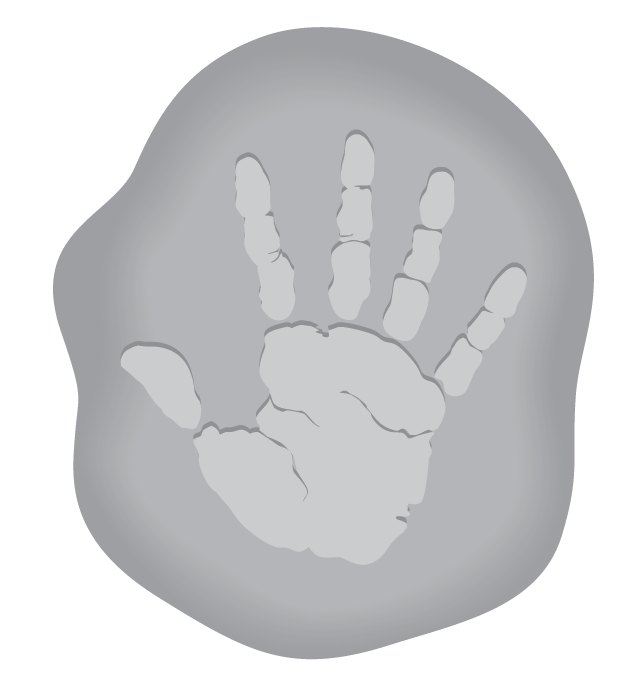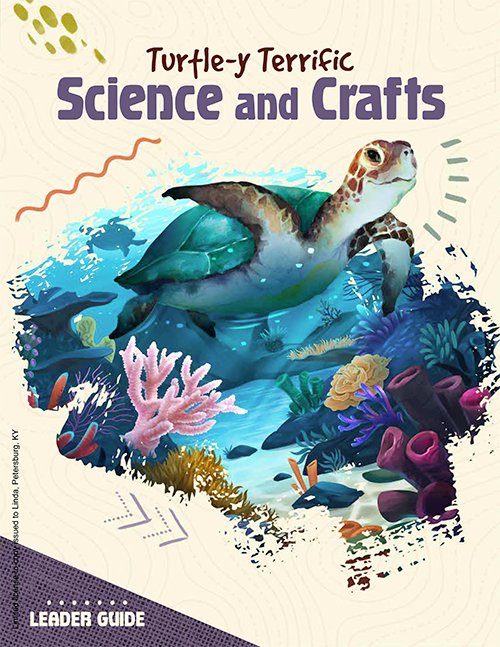Fossil Handprint
Day One Experiment
on November 24, 2021Adult supervision is required for this experiment.

Materials
- Air-dry clay, amount varies (see Tip Corner)
- Plaster of Paris*, amount varies
- Petroleum jelly, amount varies
- Paper plates, 1 per child
- Wet wipes for cleanup, 1 per child
- Zippered baggies and air-tight containers for clay, 1 baggie per child
- Optional: fossils or pictures of fossils
IMPORTANT: For safety reasons, plaster of Paris should be mixed according to manufacturer’s directions and away from children (preferably outside). Never put your hand in wet plaster of Paris. The reaction with the water creates heat that can cause burns.
Pre-Prep
Decide if the mates will make impressions of just their fingers or of their whole hand. This will affect how much clay you give them. Break or cut the air-dry clay into small to medium pieces and put into zippered baggies, then in air-tight containers. Mix the plaster of Paris just before using it.
Class Time Directions and Dialogue
Who knows what a fossil is? Take responses. Show pictures of fossils if you have any. A fossil is the remains of a plant or animal that has turned to stone. Who has heard that it takes millions and billions of years for fossils to form? Pause for responses. That’s actually not true. In order to form a fossil, you just need the right conditions—lots of water and sediments that bury animals or plants quickly. In fact, most of the fossils we find today were formed during the flood of Noah’s day. This worldwide flood had—you guessed it—lots of water and mud covering lots of animals and plants! The flood lasted about a year and happened about 4,300 years ago—not millions of years ago.
There are fossils of many plants and animals, including animals in the process of eating. It doesn’t take millions of years to eat dinner! Delicate parts like dragonfly wings have also been fossilized. What do you think would have happened to those wings if the fossilization process happened over a long period of time? Take responses: they would have decayed before they could have been fossilized.
There are also fossils of cowboy hats and teddy bears. Are they millions of years old? Of course not!
Fossils are often used to try to prove that life has been evolving for millions of years. This includes the thought that people evolved from an animal to an apelike creature to man. However, no fossils have ever been found of transitional life forms—one kind of life form changing into another completely different kind, such as an apelike creature changing into a man. Don’t you think there should be millions of these fossils, or missing links, if this were true? None have been found, and none ever will be found, because that idea isn’t true.
Also, molecules-to-man evolution involves the death of the different animals along the supposed evolutionary time line from the beginning and continuing over millions of years. But what does God teach us about his creation in the beginning? According to Genesis, God created all things, including the different kinds of animals and plants, in six days—not over millions of years. And he created them “after their kind,” which means they were to reproduce more like themselves—not change from one kind into another kind. And when God was finished, he declared everything “very good.” This happened just a few thousand years ago.
There was no death in God’s original creation. Death came as a result of the sin of the first man, Adam. If there were millions of years of fossilized bones piled up under the garden of Eden, would you consider that “very good”? Of course not. The idea of molecules-to-man evolution over millions of years isn’t true.
God has given us the account of what he did in the beginning, and we can know that his eyewitness account of how life began is true. It’s awesome to see that science backs that up. Always start with God’s Word to make sense out of the world!
Now let’s make our own fossil impression.
- Give each person a ball of air-dry clay on a paper plate. Have them flatten the clay.
- Each person should smear petroleum jelly on the inside of their fingers or hand. This is so their hand won’t stick to the clay.
- Have the kids press their fingers or their whole hand into the clay. Create a good impression by pushing down on one hand with the other hand. Remove their hand from the clay and wipe it off with a wet wipe.
- Make sure to label each impression with the child’s name.
- Teachers should carefully fill each impression in the clay with plaster of Paris. (This should be done in a spot that is away from students. Students should not work with plaster of Paris.) Because the plaster takes 20–30 minutes to set (and at least 24 hours to thoroughly dry), you may want to allow it to dry overnight. Teachers can even wait to do this step until just after all students have left.
- The next day, instruct the kids to remove the clay and reveal their “cast fossil.” Label each cast with the child’s name.
Tip Corner
- Again, a reminder to never stick your hand in wet plaster of Paris. The reaction with the water creates heat that can cause burns. Do not have children work with plaster of Paris.
- If you want kids to do their whole handprint, give them a bigger ball of clay. This also requires more plaster of Paris and more petroleum jelly per person.
- A science term introduced today is fossil.
Zoomerang Turtle-y Terrific Science & Crafts
Kids love science experiments and crafts! This guide contains everything you need to coordinate the daily science experiments and crafts for all age groups.
Browse Kids Book- © 2024 Answers in Genesis
- Privacy Policy
- Contact
- About

